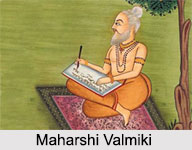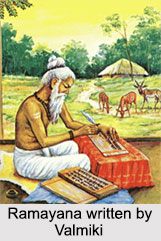 Valmiki is celebrated as the harbinger of Sanskrit literature. He is the author of the epic, Ramayana. He is referred to as the 'adikavi', the innovative creator of the Hindu 'sloka', a verse form in which most of the great epics such as Ramayana, Mahabharata, Puranas, and other works were created. He was the only person in ancient India who was the scholar in both Sanskrit and Tamil.
Valmiki is celebrated as the harbinger of Sanskrit literature. He is the author of the epic, Ramayana. He is referred to as the 'adikavi', the innovative creator of the Hindu 'sloka', a verse form in which most of the great epics such as Ramayana, Mahabharata, Puranas, and other works were created. He was the only person in ancient India who was the scholar in both Sanskrit and Tamil.
Valmiki was a Brahman by birth belonging to the family of Bhrigu. Valmiki was born as Agni Sharma. Valmiki was born with legendary tones and strings to become a Hindu sage. He was the 10th child of Pracheta. Maharshi Valmiki belongs from a Kirata Bhil community, which was essentially a backward caste community. According to myth, once he met with the great sage Narada and had a conversation with him on his duties. Motivated by Narada's words, Agni Sharma began to perform self-punishment and recited the word "Mara" which meant "kill". As he performed self-punishment for numerous years, the word became "Rama", the name of Lord Vishnu. Huge anthills formed around Agni Sharma and this earned him the name of "Valmiki".
Incarnation of Valmiki
Vishnudharmottara Purana says that Maharshi Valmiki was born in the Treta Yuga as an appearance of Lord Brahma who composed the epic Ramayana. He was later reincarnated as Tulsidas, who wrote the famous Ramcharitamanas, which was an Awadhi-Hindi description of the epic Ramayana.
Works of Valmiki
Valmiki used a lot of descriptions and metaphor in his works. His epics are very expressive. He used a mixture of short and long sentences that gives resourcefulness to his works. In one place, 38 lines (19 verses) make a single sentence. Perhaps the earliest retelling of Valmiki's poem can be found in the pages of that vast ocean of stories that one acknowledges as the Mahabharata. When Dwaipayana-Vyasa, more popularly known today as Ved Vyas, composed his equally legendary epic, he retold the story of the Ramayana in one passage.